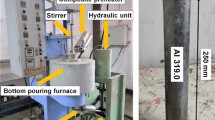Abstract
Minor alloying elements present in aluminum silicon-based casting alloys, such as sodium, strontium, or boron–titanium, could eventually affect the alloy’s microstructure and hence its mechanical properties. However, difficulties in balancing strength, ductility, and the subsequent precipitation strengthening heat treatment remain. The effects of nano-structured silanols based on partially condensed polyhedral oligomeric silsequioxanes (POSS-silanol) on the microstructure and mechanical properties of A4047 and A359 aluminum alloys were studied using a “two-step” process technique. The silanols react with active aluminum surface to form stable Si–O–Al bonds, while cage-like POSS core enables control of subsequent solidification process leading to desired mechanical performance. Using standard casting approach, the increase of both ductility and the tensile strength of the A4047 and A359 alloys is due to a highly refined fine fibrous of eutectic Al–Si formed instead of the irregular flakes as well as a refined primary aluminum phase as compared to the unmodified alloys. It has been found that this newly developed approach can also be expanded to other heat-treatable casting aluminum alloys with specific interest on changes in the microstructure of both primary aluminum phase and eutectic constituent.





Similar content being viewed by others
References
G.S. Cole, A.M. Sherman, Light weight materials for automotive applications. Mater. Charact. 35(1), 3–9 (1995)
A.M. Lovatt, D. Bassetti, H.R. Shercliff, Y. Brechet, Process and alloy selection for aluminium casting. Int. J. Cast. Metal. Res. 12(4), 211–225 (1999)
L. Backerud, G. Chai, J. Tamminen, Solidification characteristics of aluminum alloys, vol. 2. Foundry alloys (American Foundrymen’s Society Inc, Des Plaines, 1990), p. 266
C. Labrecque, M. Gagne, Ductile iron: fifty years of continuous development. Can. Metall. Q. 37(5), 343–378 (1998)
M. Felberbaum, A. Dahle, Modification and grain refinement of eutectics to improve performance of Al–Si castings. Light Metals 2011, 815–820 (2011)
A.K. Dahle, K. Nogita, J.W. Zindel, S.D. McDonald, L.M. Hogan, Eutectic nucleation and growth in hypoeutectic Al–SI alloys at different strontium levels. Metall. Mater. Trans. A 32(4), 949–960 (2001)
M.M. Barzani, S. Farahany, N.M. Yusof, A. Ourdjini, The influence of bismuth, antimony, and strontium on microstructure, thermal, and machinability of aluminum–silicon alloy. Mater. Manuf. Process. 28(11), 1184–1190 (2013)
G. Sigworth, The modification of Al–Si casting alloys: important practical and theoretical aspects. Int. J. Metalcasting 2(2), 19–41 (2008)
J.A. Marc Antonio, L.F. Mondo Lfo, Grain refinement in aluminum alloyed with titanium and boron. Metall. Trans. 2(2), 465–471 (1971)
B. Suárez-Peña, J. Asensio-Lozano, J.I. Verdeja-Gonzalez, J.A. Pero-Sanz Elorz, Microstructural effects of phosphorus on pressure die cast Al–12Si components. Rev. Metal. 43(5), 352–359 (2007)
A. Lee, K.N. Subramanian, Development of nano-composite lead-free electronic solders. J. Electron. Mater. 34(11), 1399–1407 (2005)
M.G. Day, A. Hellawel, Microstructure and crystallography of aluminium–silicon eutectic alloys. Proc. R. Soc. Lond. A 305(183), 473–491 (1968)
M.H. Kim et al., The effects of Ti and Sr on the microstructures of Al-11.3 wt.% Si alloys produced by the ohno continuous casting process. Met. Mater. 6(3), 235–240 (2000)
G. Sierra et al., Steel to aluminium braze welding by laser process with Al–12Si filler wire. Sci. Technol. Weld. Join. 13(5), 430–437 (2008)
Y. Li, K.T. Ramesh, E.S.C. Chin, The mechanical response of an A359/SiC MMC and the A359 aluminum matrix to dynamic shearing deformations. Mater. Sci. Eng. A 382(1), 162–170 (2004)
J.G. Kaufman et al., Properties of aluminum alloys: tensile, creep, and fatigue data at high and low temperatures (ASM international, Almere, 1999)
Author information
Authors and Affiliations
Corresponding author
Rights and permissions
About this article
Cite this article
Lee, A., Lu, Y., Roche, A. et al. Influence of Nano-Structured Silanols on the Microstructure and Mechanical Properties of A4047 and A359 Aluminum Casting Alloys. Inter Metalcast 10, 338–341 (2016). https://doi.org/10.1007/s40962-016-0044-4
Published:
Issue Date:
DOI: https://doi.org/10.1007/s40962-016-0044-4




